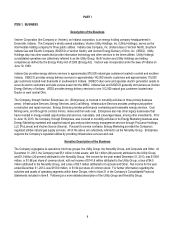Vectren 2013 Annual Report Download - page 21
Download and view the complete annual report
Please find page 21 of the 2013 Vectren annual report below. You can navigate through the pages in the report by either clicking on the pages listed below, or by using the keyword search tool below to find specific information within the annual report.
19
If the rating agencies downgrade the Company’s credit ratings, particularly below investment grade, or initiate negative outlooks
thereon, or withdraw the Company's ratings or, in each case, the ratings of its subsidiaries, it may significantly limit the
Company's access to the debt capital markets and the commercial paper market, and the Company’s borrowing costs would
increase. In addition, the Company would likely be required to pay a higher interest rate in future financings, and its potential
pool of investors and funding sources would likely decrease. Finally, there is no assurance that the Company will have access
to the equity capital markets to obtain financing when necessary or desirable.
Utility Operating Risks
Vectren’s gas and electric utility sales are concentrated in the Midwest.
The operations of the Company’s regulated utilities are concentrated in central and southern Indiana and west central Ohio and
are therefore impacted by changes in the Midwest economy in general and changes in particular industries concentrated in the
Midwest. These industries include automotive assembly, parts and accessories; feed, flour and grain processing; metal
castings, aluminum products, polycarbonate resin (Lexan®) and plastic products; gypsum products; electrical equipment, metal
specialties, glass and steel finishing; aluminum smelting and recycling; pharmaceutical and nutritional products; gasoline and oil
products; ethanol; and coal mining.
Vectren’s regulated utilities operate in an increasingly competitive industry, which may affect its future earnings.
The utility industry has been undergoing structural change for several years, resulting in increasing competitive pressure faced
by electric and gas utility companies. Increased competition, including those from cogeneration, solar, and other renewables
opportunities for customers, may create greater risks to the stability of Vectren’s earnings generally and may in the future reduce
its earnings from retail electric and gas sales. In this regard, the deployment and commercialization of disruptive technologies,
such as renewable energy sources and cogeneration facilities, have the potential to change the nature of the utility industry and
reduce demand for Vectren’s electric and gas products and services. If the Company is not able to appropriately adapt to
structural changes in the utility industry as a result of the development of disruptive technologies, this may have an adverse
effect on the Company’s financial condition and results of operations. Additionally, several states, including Ohio, have passed
legislation that allows customers to choose their electricity supplier in a competitive market. Indiana has not enacted such
legislation but has recently begun to explore electric choice options. Ohio regulation also provides for choice of commodity
providers for all gas customers. The Company implemented this choice for its gas customers in Ohio and is currently in the
second of the three phase process to exit the merchant function in its Ohio service territory. The state of Indiana has not
adopted any regulation requiring gas choice in the Company’s Indiana service territories; however, the Company operates under
approved tariffs permitting certain industrial and commercial large volume customers to choose their commodity
supplier. Vectren cannot provide any assurance that increased competition or other changes in legislation, regulation or policies
will not have a material adverse effect on its business, financial condition or results of operations.
A significant portion of Vectren’s electric utility sales are space heating and cooling. Accordingly, its operating results
may fluctuate with variability of weather.
Vectren’s electric utility sales are sensitive to variations in weather conditions. The Company forecasts utility sales on the basis
of normal weather. Since Vectren does not have a weather-normalization mechanism for its electric operations, significant
variations from normal weather could have a material impact on its earnings. However, the impact of weather on the gas
operations in the Company’s Indiana territories has been significantly mitigated through the implementation of a normal
temperature adjustment mechanism. Additionally, the implementation of a straight fixed variable rate design mitigates most
weather variations related to Ohio residential gas sales.
Vectren’s utilities are exposed to increasing regulation, including pipeline safety, environmental, and cybersecurity
regulation.
Vectren's utilities are subject to regulation by federal, state, and local regulatory authorities and are exposed to public policy
decisions that may negatively impact the Company's earnings. In particular, Vectren is subject to regulation by the FERC, the
























